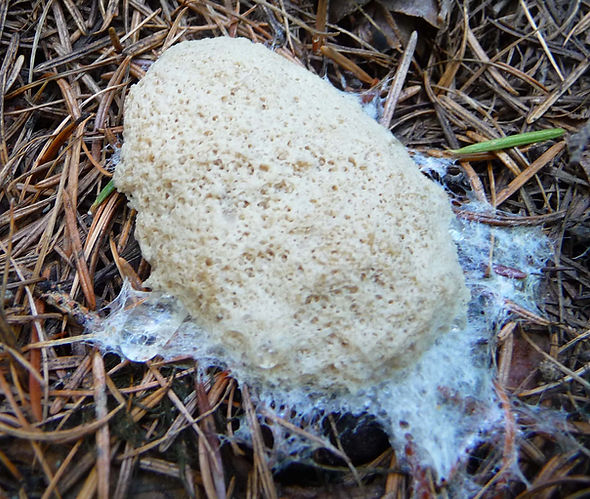Mysterious myxomycetes
- Kent Goodwin
- Sep 28, 2018
- 2 min read
Walking Upper Army Road earlier this summer, I noticed a white fist-sized blob tucked in among the Oregon grape and kinnikinnick beside the trail. It appeared to resemble a clump of cauliflower. Quite curious, I picked up a stick and gave it a poke. The clump had a soft, porridge-like consistency that easily mushed apart with my prodding.
Weird.
I took a few pictures and set off for home to do some research.

This textured white ball was discovered on Upper Army Road this summer.
That’s how I was introduced the bizarre and wonderful world of Myxomycetes. More commonly known as slime molds, these fascinating life forms are not plants or fungi, but rather occupy their own branch of the evolutionary tree. In my case, the slime mold I found in the park was called Fuligo septica.
Slime molds begin their lives as spores -- microscopic balls that, when conditions are right, burst open and release tiny amoebas. When this happens in wet areas where free water is present, the amoebas become swarm cells and develop little flagella, or tails, that allow them to swim around looking for food. If conditions are dry, they remain as amoebas and crawl around the substrate looking for bacteria to digest.
At some point, when the numbers of amoeba are high enough, two of them from different parents will join together, combining their genetic material in one nucleus. The nucleus will then start dividing, and the amoeba will grow into a larger mass called a plasmodium.

The plasmodium of Fuligo septica can vary in texture and colour, depending on its stage of life.
A plasmodium is in essence one giant cell with thousands of nuclei. Amazingly, by streaming their protoplasm in one direction and withdrawing it from the other, the plasmodia can crawl across the forest floor in search of food. When you see a slime mold in the nature park, you can often see a residue of slime trailing behind it.

You can see the slime trail behind this Myxo as it crawls across the forest floor.
At some point, in response to environmental conditions such as a shortage of food, the plasmodium will settle down and begin to dry out, forming an aethelium, or spore-producing body. When the plasmodium senses this impending change, it will sometimes move to a higher location to more successfully scatter its spores.

This plasmodium is climbing up a branch in preparation for sporing.
In the case of the slime mold I found in the park, Fuligo septica, the whole aethelium disintegrates over a few days into a mass of spores. Those spores start the life cycle all over again.

A Fuligo septica aethelium disintegrates into a mass of dark-coloured spores.
I have been enjoying the nature park for more than 35 years, but before this summer I had been unaware that slime molds were a part of its ecosystem. Now I will be looking for them every time I go for a hike.
























